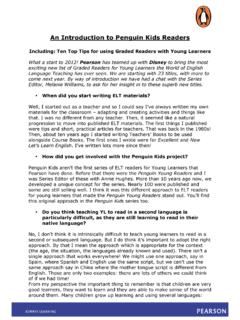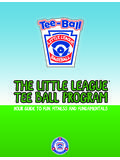Transcription of CHILDREN AND THEIR CHALLENGES - ENNEAGRAM
1 CHILDREN AND THEIR CHALLENGES Using the ENNEAGRAM to Work with Youth Creating understanding for a more harmonious future By: Marco Nieuwenhuize and Joanne Majewski Joanne: Marco: Copyright Marco Nieuwenhuize and Joanne Majewski, 2001 Material by Elizabeth Wagele printed with her permission Merlin The Netherlands Website: Copyright 2001 Joanne Majewski, Marco Nieuwenhuize 1 About This Guide This workbook blends together the ENNEAGRAM personality system, and practical ways of working with youth. There is not a lot of published writing about how kids and adolescents display different ENNEAGRAM types, so this workbook pulls together existing information and our own observations from working with CHILDREN and teenagers. We are dedicated to working with kids , and to helping people better understand youth in today's society.
2 We are constantly looking for ways to help kids live happy and healthy lives. We want to thank Elizabeth Wagele who wrote an excellent book about how to use the ENNEAGRAM with CHILDREN (The ENNEAGRAM of Parenting). She gave us permission to use her work; her descriptions are foundation of this paper. We are also using material from ENNEAGRAM writers Helen Palmer, Don Richard Riso and Russ Hudson, and Kathy Hurley and Theodore Donson. Books of these teachers are The ENNEAGRAM by Helen Palmer, The Wisdom of the ENNEAGRAM by Don Richard Riso and Russ Hudson, and My Best Self by Kathy Hurley and Theodorre Donson. Other used material is mentioned in the bibliography. From Marco The CHILDREN of these times receive many more impulses. For example, television, computer games, internet, mobile phone, and the stress from our surroundings cause the CHILDREN to react differently than 20 year ago.
3 My work with the ENNEAGRAM and CHILDREN is aimed at creating understanding with parents, teachers, and others for why certain CHILDREN become more active, why certain CHILDREN withdraw, and why others just keep on following the rules. Using the simple tools we teach has proven to be very effectively in creating an environment that gives CHILDREN the right discipline, right attention, and right structure. CHILDREN love these tools and become much more centered when they have it. From Joanne I have been working with and facilitating youth groups for six years, but most of my current perspectives come from my experience at the Sprite Program. Sprite is an experiential education program for teen boys and girls who are in prison. If the kids graduate the month long program, which consists of five segments (orientation, rock climbing, expedition, community service, and urban), then they get released from prison, and can go home.
4 It is not an easy program to graduate from, so the kids have to truly prove that they are ready to be released into the community. I have learned so much from the program, the staff, and of course, the teens. The program is excellent, and I can see how it helps gives kids the life tools that they need to be successful. I want to thank the staff, who are incredibly experienced in working with youth, and THEIR pure investment is what makes Sprite a successful program. I am fortunate enough to be able to work with these kids . From THEIR stories, I can learn about THEIR past and how THEIR environment affected THEIR lives, but I can also see how they have decided to make some changes in THEIR life due to being incarcerated. These boys and girls experienced extremely stressful situations and living environments, and they made some bad decisions.
5 Now, after having a lot of time in prison to think about THEIR lives, many of them have a good understanding of themselves and THEIR unhealthy patterns, and are ready to make a change. THEIR names have been changed in the stories that I use. Copyright 2001 Joanne Majewski, Marco Nieuwenhuize 2 Table of Contents The first part of this guide is to create a better understanding of CHILDREN , and the second half discusses practical ways to work with them. Introduction CHILDREN and THEIR Personality Using the ENNEAGRAM with Youth Introducing the Nine Types Wings of the ENNEAGRAM Arrows Creating an Understanding The Nine Types of CHILDREN and THEIR Personality Descriptions The Learning Styles of the ENNEAGRAM Types Sometimes the ENNEAGRAM is not a good thing Going Deeper into the Personality The Three Centers The Hornevian Model Creating Balance Introduction Creating a Foundation Building Relationships Understanding Yourself The Art of Listening The Revolutionary Potential of Every Person Resilience Factors and the ENNEAGRAM The Core Quality Quadrant No Pain.
6 No Gain Giving kids a Chance to Give Alternative Ways of Working with Youth The Great Outdoors Creating Stress Creating Relaxation Programming with Youth The Staff Balanced Programming Group Therapy Understanding ADHD: A Summary of Working with Youth Copyright 2001 Joanne Majewski, Marco Nieuwenhuize 3 CHILDREN and THEIR Personality What motivates kids ? Why do some kids fight, while others retreat and go inside themselves? Why are some kids stressed because they always want to "do the right thing," while others seem to constantly push THEIR boundaries? Some kids run away from THEIR problems, and others look for continual guidance. With all of these differences, how can we understand a child's subtle needs? kids personalities are as complex and varied as our own. We want to help kids grow and develop, but if we do not understand THEIR personality characteristics, we end up giving them what we would want, and not what they need.
7 For example, when a child is feeling down, Joanne's first instinct would be to take him out for ice cream, but maybe all he wants is some time alone to process his feelings! Our own personalities affect the way we work with CHILDREN , and our first response may not always be what a certain child needs. The ENNEAGRAM is an ancient personality system that can help people interact with others. It is a useful tool to understand different types of kids and THEIR patterns, and to see how adult personality types work with CHILDREN . By understanding people's motivations, and how different people respond to stress, we can begin to see how kids learn, what resilience factors contribute to THEIR successes, and what different kids look for in a mentor. Then we can learn about ourselves, and how to work with kids in an effective and balanced way.
8 Through the ENNEAGRAM , we can begin to see why kids are facing so many CHALLENGES today. For example, we can see why certain kids may display ADHD characteristics, and then find ways to help them without using prescription drugs. We can see why some kids are withdrawing from society, and turning to heavy drug usage, while others choose to sell drugs. We are not proposing easy answers to these CHALLENGES , but we can begin to understand why kids are acting out in different ways, and can see possible ways to respond both in reactive and proactive ways. ENNEAGRAM Model Copyright 2001 Joanne Majewski, Marco Nieuwenhuize 4 Using the ENNEAGRAM with Youth The ENNEAGRAM describes nine different personality styles. We have all of the types within us, but one is more dominant, and may not become apparent until maturity.
9 kids are still developing and figuring out who they are, so they may show characteristics of one, two, or three types, and these types may not even reflect what type they will be as adults. When using the ENNEAGRAM to understand CHILDREN , it is important that we do not put them into a box. Each child is special and unique, and THEIR entire being is much deeper than what personality characteristics they display. The reason the ENNEAGRAM is helpful is so we can attune ourselves to how other people experience the world. Because we have only lived as ourselves, it is hard to understand what others may be thinking or feeling, and why they do the (sometimes bewildering!) things that they do. The ENNEAGRAM is helpful when we use it as a tool to understand ourselves and others, but it should not be imposed on other people--especially CHILDREN !
10 From the ENNEAGRAM we can learn about kids , and practical techniques to work with them, but we should not see our kids as types. We can use the ENNEAGRAM like a rough map--we have a general idea from the lines on the map where we are, and where we may be going, but in the end, each individual has to experience the world first hand to choose where he or she wants to go. Introducing the Nine Types From The ENNEAGRAM of Parenting by Elizabeth Wagele ENNEAGRAM types have many different names. We are using these names because they apply best to CHILDREN . 1: The Perfectionist wants to do everything just right and is often self-critical. 2: The Helper wants to be of assistance and to be liked, and often masks his or her own feelings and needs. 3: The Achiever is driven to perform well and to win approval.






